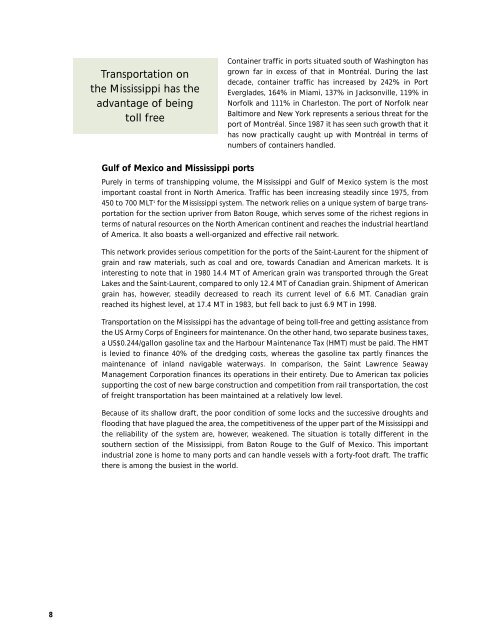Québec Marine Transportation Policy - Transport - Gouvernement ...
Québec Marine Transportation Policy - Transport - Gouvernement ...
Québec Marine Transportation Policy - Transport - Gouvernement ...
Create successful ePaper yourself
Turn your PDF publications into a flip-book with our unique Google optimized e-Paper software.
8<br />
<strong><strong>Transport</strong>ation</strong> on<br />
the Mississippi has the<br />
advantage of being<br />
toll free<br />
Gulf of Mexico and Mississippi ports<br />
Container traffic in ports situated south of Washington has<br />
grown far in excess of that in Montréal. During the last<br />
decade, container traffic has increased by 242% in Port<br />
Everglades, 164% in Miami, 137% in Jacksonville, 119% in<br />
Norfolk and 111% in Charleston. The port of Norfolk near<br />
Baltimore and New York represents a serious threat for the<br />
port of Montréal. Since 1987 it has seen such growth that it<br />
has now practically caught up with Montréal in terms of<br />
numbers of containers handled.<br />
Purely in terms of transhipping volume, the Mississippi and Gulf of Mexico system is the most<br />
important coastal front in North America. Traffic has been increasing steadily since 1975, from<br />
450 to 700 MLT 1 for the Mississippi system. The network relies on a unique system of barge transportation<br />
for the section upriver from Baton Rouge, which serves some of the richest regions in<br />
terms of natural resources on the North American continent and reaches the industrial heartland<br />
of America. It also boasts a well-organized and effective rail network.<br />
This network provides serious competition for the ports of the Saint-Laurent for the shipment of<br />
grain and raw materials, such as coal and ore, towards Canadian and American markets. It is<br />
interesting to note that in 1980 14.4 MT of American grain was transported through the Great<br />
Lakes and the Saint-Laurent, compared to only 12.4 MT of Canadian grain. Shipment of American<br />
grain has, however, steadily decreased to reach its current level of 6.6 MT. Canadian grain<br />
reached its highest level, at 17.4 MT in 1983, but fell back to just 6.9 MT in 1998.<br />
<strong><strong>Transport</strong>ation</strong> on the Mississippi has the advantage of being toll-free and getting assistance from<br />
the US Army Corps of Engineers for maintenance. On the other hand, two separate business taxes,<br />
a US$0.244/gallon gasoline tax and the Harbour Maintenance Tax (HMT) must be paid. The HMT<br />
is levied to finance 40% of the dredging costs, whereas the gasoline tax partly finances the<br />
maintenance of inland navigable waterways. In comparison, the Saint Lawrence Seaway<br />
Management Corporation finances its operations in their entirety. Due to American tax policies<br />
supporting the cost of new barge construction and competition from rail transportation, the cost<br />
of freight transportation has been maintained at a relatively low level.<br />
Because of its shallow draft, the poor condition of some locks and the successive droughts and<br />
flooding that have plagued the area, the competitiveness of the upper part of the Mississippi and<br />
the reliability of the system are, however, weakened. The situation is totally different in the<br />
southern section of the Mississippi, from Baton Rouge to the Gulf of Mexico. This important<br />
industrial zone is home to many ports and can handle vessels with a forty-foot draft. The traffic<br />
there is among the busiest in the world.


